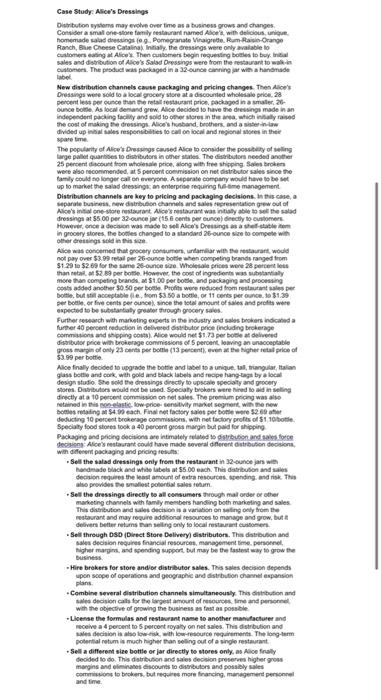Question
Us ing the above case synopsis , select a target market, and answer the following questions as a guideline for your case analysis: 1. What
Using the above case synopsis, select a target market, and answer the following questions as a guideline for your case analysis:

Present an analysis of the following case, answering all questions. (40 points)
Case Study: Alice's Dressings |
|
Distribution systems may evolve over time as a business grows and changes. Consider a small one-store family restaurant named Alice's, with delicious, unique, homemade salad dressings (e.g., Pomegranate Vinaigrette, Rum-Raisin-Orange Ranch, Blue Cheese Catalina). Initially, the dressings were only available to customers eating at Alice's. Then customers begin requesting bottles to buy. Initial sales and distribution of Alice's Salad Dressings were from the restaurant to walk-in customers. The product was packaged in a 32-ounce canning jar with a handmade label. New distribution channels cause packaging and pricing changes. Then Alice's Dressings were sold to a local grocery store at a discounted wholesale price, 28 percent less per ounce than the retail restaurant price, packaged in a smaller, 26-ounce bottle. As local demand grew, Alice decided to have the dressings made in an independent packing facility and sold to other stores in the area, which initially raised the cost of making the dressings. Alice's husband, brothers, and a sister-in-law divided up initial sales responsibilities to call on local and regional stores in their spare time. The popularity of Alice's Dressings caused Alice to consider the possibility of selling large pallet quantities to distributors in other states. The distributors needed another 25 percent discount from wholesale price, along with free shipping. Sales brokers were also recommended, at 5 percent commission on net distributor sales since the family could no longer call on everyone. A separate company would have to be set up to market the salad dressings; an enterprise requiring full-time management. Distribution channels are key to pricing and packaging decisions. In this case, a separate business, new distribution channels and sales representation grew out of Alice's initial one-store restaurant. Alice's restaurant was initially able to sell the salad dressings at $5.00 per 32-ounce jar (15.6 cents per ounce) directly to customers. However, once a decision was made to sell Alice's Dressings as a shelf-stable item in grocery stores, the bottles changed to a standard 26-ounce size to compete with other dressings sold in this size. Alice was concerned that grocery consumers, unfamiliar with the restaurant, would not pay over $3.99 retail per 26-ounce bottle when competing brands ranged from $1.29 to $2.69 for the same 26-ounce size. Wholesale prices were 28 percent less than retail, at $2.89 per bottle. However, the cost of ingredients was substantially more than competing brands, at $1.00 per bottle, and packaging and processing costs added another $0.50 per bottle. Profits were reduced from restaurant sales per bottle, but still acceptable (i.e., from $3.50 a bottle, or 11 cents per ounce, to $1.39 per bottle, or five cents per ounce), since the total amount of sales and profits were expected to be substantially greater through grocery sales. Further research with marketing experts in the industry and sales brokers indicated a further 40 percent reduction in delivered distributor price (including brokerage commissions and shipping costs). Alice would net $1.73 per bottle at delivered distributor price with brokerage commissions of 5 percent, leaving an unacceptable gross margin of only 23 cents per bottle (13 percent), even at the higher retail price of $3.99 per bottle. Alice finally decided to upgrade the bottle and label to a unique, tall, triangular, Italian glass bottle and cork, with gold and black labels and recipe hang-tags by a local design studio. She sold the dressings directly to upscale specialty and grocery stores. Distributors would not be used. Specialty brokers were hired to aid in selling directly at a 10 percent commission on net sales. The premium pricing was also retained in this non-elastic, low-price- sensitivity market segment, with the new bottles retailing at $4.99 each. Final net factory sales per bottle were $2.69 after deducting 10 percent brokerage commissions, with net factory profits of $1.10/bottle. Specialty food stores took a 40 percent gross margin but paid for shipping. Packaging and pricing decisions are intimately related to distribution and sales force decisions: Alice's restaurant could have made several different distribution decisions, with different packaging and pricing results: Sell the salad dressings only from the restaurant in 32-ounce jars with handmade black and white labels at $5.00 each. This distribution and sales decision requires the least amount of extra resources, spending, and risk. This also provides the smallest potential sales return. Sell the dressings directly to all consumers through mail order or other marketing channels with family members handling both marketing and sales. This distribution and sales decision is a variation on selling only from the restaurant and may require additional resources to manage and grow, but it delivers better returns than selling only to local restaurant customers. Sell through DSD (Direct Store Delivery) distributors. This distribution and sales decision requires financial resources, management time, personnel, higher margins, and spending support, but may be the fastest way to grow the business. Hire brokers for store and/or distributor sales. This sales decision depends upon scope of operations and geographic and distribution channel expansion plans. Combine several distribution channels simultaneously. This distribution and sales decision calls for the largest amount of resources, time and personnel, with the objective of growing the business as fast as possible. License the formulas and restaurant name to another manufacturer and receive a 4 percent to 5 percent royalty on net sales. This distribution and sales decision is also low-risk, with low-resource requirements. The long-term potential return is much higher than selling out of a single restaurant. Sell a different size bottle or jar directly to stores only, as Alice finally decided to do. This distribution and sales decision preserves higher gross margins and eliminates discounts to distributors and possibly sales commissions to brokers, but requires more financing, management personnel and time. | |
|
|
| |
Step by Step Solution
There are 3 Steps involved in it
Step: 1

Get Instant Access to Expert-Tailored Solutions
See step-by-step solutions with expert insights and AI powered tools for academic success
Step: 2

Step: 3

Ace Your Homework with AI
Get the answers you need in no time with our AI-driven, step-by-step assistance
Get Started


